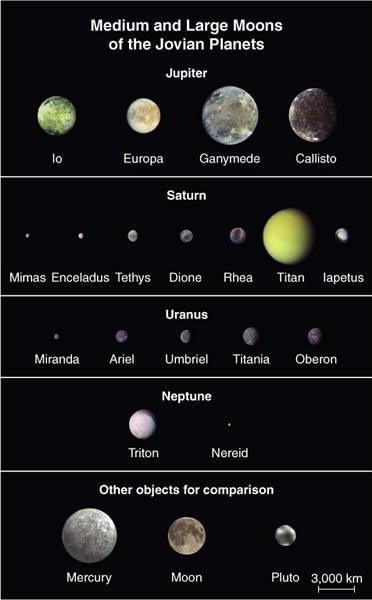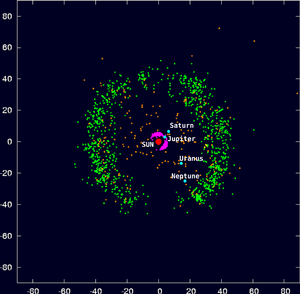To help people visualize the relative sizes of things in our solar system, here is a convenient analogy. I matched up Sun-orbiting objects with comparable animals based on mass (divided by ~400 sextillion). Traveling outward from the Sun, we have:
| Mercury | Ferret |
| Venus | Beagle |
| Earth | Cocker Spaniel |
| Mars | Chihuahua |
| Vesta (asteroid) | Scarab Beetle |
| Juno (asteroid) | Damselfly |
| hundreds of other asteroids | Fruit Flies & Gnats |
| Ceres (asteroid) | Locust |
| Jupiter | Elephant |
| Saturn | Giraffe |
| Uranus | Wildebeest (dusty) |
| Neptune | Wildebeest (waterlogged) |
| Pluto (plutoid KBO) | Prawn (medium) |
| thousands of other plutoids | Krill & Brine Shrimp |
| Eris (plutoid SDO) | Prawn (large) |
| Sedna (plutoid DDO) | Grey Shrimp |
Yes, there really is that much difference in size between the inner planets and the plutoids. On this scale the moons Ganymede, Titan and Callisto would be large rats, while Io, Europa, and our Moon would be hamsters. All much larger than Pluto.
p.s. The Sun would be a cargo ship the length of a football field. Noah's Ark, perhaps?

An Alternate Analogy
Our solar system is:
- a campfire (the Sun)
- four marbles (inner planets)
- a circle of sand (asteroids)
- four nerf balls (outer planets)
- a circle of sleet (plutoids)
(then spread them outward across empty land the size of a city)

green = Pluto and its siblings
There is no need to mourn that Pluto has "left the Planet family". Pluto is at best a 2nd cousin of Earth, and it already has a thousand closer relatives. The plutoids never come to our reunion cookouts anyways, so what's the problem?
Last, arguments based on "tradition" are also invalid, because removing planethood from a category of objects is plenty traditional. The exact same thing happened to the asteroids. All the science books called Ceres a planet for over 50 years, and kept adding as more were discovered (in 1851 the list of planets included Pallas, Juno, Vesta, Astrea, Hebe, Iris, Flora, Metis, Hygeia, Parthenope, Victoria, Egeria, Irene, and Eunomia) until people agreed that the numerous asteroids deserved their own separate category.
Pluto is just like that: one of the larger members of a specific population, different in character from Earth and its siblings.